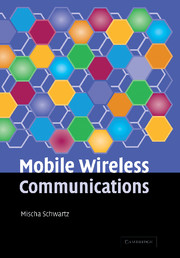Book contents
- Frontmatter
- Contents
- Preface
- 1 Introduction and overview
- 2 Characteristics of the mobile radio environment–propagation phenomena
- 3 Cellular concept and channel allocation
- 4 Dynamic channel allocation and power control
- 5 Modulation techniques
- 6 Multiple access techniques: FDMA, TDMA, CDMA; system capacity comparisons
- 7 Coding for error detection and correction
- 8 Second-generation, digital, wireless systems
- 9 Performance analysis: admission control and handoffs
- 10 2.5G/3G Mobile wireless systems: packet-switched data
- 11 Access and scheduling techniques in cellular systems
- 12 Wireless LANs and personal-area networks
- References
- Index
8 - Second-generation, digital, wireless systems
Published online by Cambridge University Press: 05 June 2012
- Frontmatter
- Contents
- Preface
- 1 Introduction and overview
- 2 Characteristics of the mobile radio environment–propagation phenomena
- 3 Cellular concept and channel allocation
- 4 Dynamic channel allocation and power control
- 5 Modulation techniques
- 6 Multiple access techniques: FDMA, TDMA, CDMA; system capacity comparisons
- 7 Coding for error detection and correction
- 8 Second-generation, digital, wireless systems
- 9 Performance analysis: admission control and handoffs
- 10 2.5G/3G Mobile wireless systems: packet-switched data
- 11 Access and scheduling techniques in cellular systems
- 12 Wireless LANs and personal-area networks
- References
- Index
Summary
In this chapter we discuss current second-generation digital cellular systems. Some mention has already been made of these systems in Chapter 6, in the context of TDMA and CDMA, as well as in discussing their capacities comparatively. In particular, we discussed the North-American TDMA-based IS-136 or D-AMPS, the digital follow-on to the first-generation AMPS analog cellular system; GSM, the TDMA-based pan-European system, which is also being deployed in the USA and elsewhere in the world; and the CDMA-based IS-95. We now go over these systems in more detail, describing first the signaling required across the air-interface between the mobile station (MS) and the base station (BS) to establish and receive calls. We then discuss the signaling required within the wired network to which the base stations are connected, to control mobile handoffs from one cell to another, as well as the signaling required to locate and page a mobile in order to deliver an incoming call. We conclude the chapter with a brief discussion of voice signal processing and coding in these systems.
A much simplified diagram of a second-generation cellular system appears in Fig. 8.1. A given base station (BS) will typically control multiple mobile stations (MS). (The North American standard calls the mobile a cellular subscriber station, CSS.) Multiple base stations are, in turn, controlled by a mobile switching center (MSC), responsible for handling inter-cellular handoff, as well as mobile location, paging, and other mobile management and control functions.
- Type
- Chapter
- Information
- Mobile Wireless Communications , pp. 199 - 257Publisher: Cambridge University PressPrint publication year: 2004



